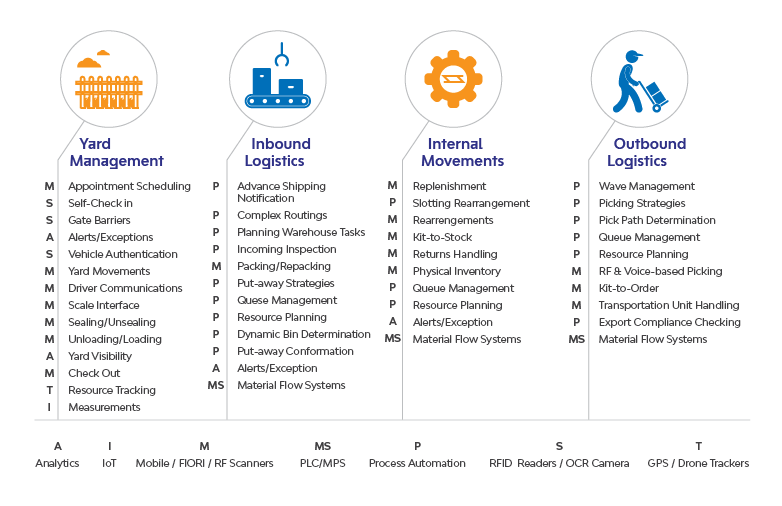Smart Warehousing leveraging Physical to Digital interventions
Warehouse Management, plays a crucial role in supply chain by orchestrating the flow of material & information in order fulfilment. Warehouses have evolved from simple receiving, storage, and shipping facilities to full-scale, high-volume, flow-through distribution operations.
Physicals to digital intersection has shifted the traditional warehouse operating paradigm in sophisticated automation. Companies are seeking ways to maximize throughput, while enhancing order fulfilment accuracy& speedby using automated materials handling WCS.
In all major industries (like Automotive, Chemicals, Hi-tech, CPMG, Retail, Life Science, Service Part Management, 3PL, and food processing, etc.) warehouses automation has become the norm. Hence companies looking next-generation warehousehaving ability to natively interface with WCS technologies like GTP (Goods-to-Person) or PTG (Person-to-Goods) and significantly change the way goods are received, stored and shipped to transform the Supply Chain.
Reasons for Warehouse Investment
Global competition has driven businesses to hold less inventory and to get their products to market both faster and on time. Competition has also driven both local and global corporations to become leaner and more efficient, and to react faster to changes in the marketplace and in the internal business environment. Following are key KPIs for next generation warehouse:
- Higher customer service
- Increased efficiency & productivity
- Process automation and scalability
- Reduced inventory & labour costs
- Greater visibility & decision support
- Compliance and sustainability
Leads to achieve business objectives
Constantly shifting business priorities, increasing seasonality of products, faster business cycles, and more frequent mergers and acquisitions, are just some of the market conditions that lead to intense pressure on warehouses to increase efficiency, while still providing flexibility to the business to allow it to react to changing demands. To achieve the business KPIs, the proposed warehouse solution should have following key capabilities:
- On-time customer order fulfillment
- Reduce the order to pick up time (reducing lengthy pickers travels)
- Ensure accuracy of pickup by deploying goods-to-person or person-to-goods principles
- Maximize the space utilization by using automatic WCS
- Avoid excessive return costs (increase the pick accuracy)
- Avoid excessive return costs (increase the pick accuracy)
- Ergonomic physicals to ensure optimum employee throughput
- Effective and inexpensive productivity scaling to manage seasonal demands
- Efficient hazardous substance handling &dangerous goods management
- Smooth integration with production planning and quality management
- Increased track & trace by batch management & serialization
- Interactive, graphical workload overview
- Graphical visualization of warehouse & yard layout
- Reduced IT Supports needed for logistics
Physicals & Digitisation Intersection (WCS or MFS)
Material flow system (Goods to Person & Person to Goods), machine learning / artificial learning, big data analytics, Internet of things (IoT), Drone, RFID, GPRS /GPS, SaaS (Cloud solutions) and Mobile technologies, have brought a revolution in logistics execution. This has enabled data flow volume management, variety & velocity,while ensuring improved accuracy, visibility & trace ability across the supply.
All industries are trying to equip their logistics solutions, with the state-of-the-art technologies,while balancing “Optimum utilisations of current IT Infrastructure v/s exploiting the benefits new technologies”.
Irrespective of size (small, medium or complex, 3PL & 4PL), warehouses are operating with variety of WCS or WebSphere Commerce . It has resulted in sophistication& optimisation in managing warehouse ground level task execution, space optimisation, speed and accuracy in material placement& retrieval. It is agile and able to complete warehouse tasks through communication with automation equipment.
WCS communicates with WMS solution via PLC (programmable logic controller). WMS focuses on the high level maintaining inventory, and orders while WCS focusing on efficient completion of floor level tasks executions, with speed & accuracy; irrespective volume.
Example of “Goods-to-person” MFS
- Automated Guided vehicles (AVG)
- Self-guided forklift
- Auto-guided mini-robot
- High-speed conveyor shuttles packages
- Driverless tractor-trailer
- Highly automated modular conveyor system
Example of “Persons-to Goods” MFS
- Pick to Voice
- Pick to Light
- RF Scanners
RFID Scanners /readers has brought the revolution in warehouse operation by touchless scanning of RFID tags, validate the data with ERP system and book voluminous the business transactions with speed & accuracy. RFID scanners with drone technology has established a land mark in tracking & Tracking the equipment’s, containers, in yard management. It will no wonders to say, drones will complete the physical inventory in warehouse when no one was there. RFID will also play an important role in controlling the yard check-in traffic by automation of gate barriers.
SAP EWM Process: Value Chain Overview

Critical Success Factors in Selecting WMS
- WMS solutions global coverage and scalability
- Next-generation warehouse house solution should ensure global functional coverage
- Has capability to natively integrate with latest technologies like RFID, MFS, AGV
- Scalability to manage small, medium & complex warehouse
- Ability of mapping of physical warehouse structure, layouts & flow of materials
- WMS solution capability to manage quality master data
- Data quality makes or breaks the solution
- Quality data is key for process automation
- Quality data ensures successful collaborating / integration with latest technologies
- Quality data avoids disruption and ensures transactional accuracy in the production environment
- Ability to manage batch management & serialization
- Time overruns in rolling out the solution globally
- Global template functionality coverage & language support
- Template governance and localizations
- Complexity and WCS integration at each rollouts
- Gaps in integrated process design
- Assessment of WMS integration impact on SAP TM, YL, EM, ECC ,GTS, BW & Third-party solution
- Design for regional variations to ensure global coverage
- Alignment with complex and evolving technology landscape to avoid project overrun
- Sub-optimal value realization due to low adoption by personas
- Ease of comparing old vs. new material movements recommendations to ensure user confidence
- Solution design to enable users respond to real-time changing business conditions
SAP EWM –Next Generation WMS Solution
SAP EWM has been positioned as the next-generation warehouse management solution, capable to easily integrate with the state-of-art-warehouse physicals to accomplish process flexibility, performance and functionalities coverage. Its functionality coverage makes it suitable for all industry verticals, DCs, 3PL, 4PL, manufacturing warehouse irrespective warehouse size (Small, medium & Complex).
It offers most of the best-in-class warehouse functionalities, ensuring deep process integration, powerful decision support (analytics), and native integration with physicals operating with Goods-to-Person or Person-to Goods principles, its flexibility and scalability to respond business needs.
More from KM Jadhav
Read More- Part 1 Introduction In today's rapidly evolving digital landscape, companies must…
In today's fast-paced world, supply chain disruptions are increasing at an alarming rate, making…
Latest Blogs
In today’s data-driven world, collaboration is no longer an option—it’s a necessity.…
Software development has evolved remarkably over the past few decades. From the days of traditional,…
Introduction The global financial services sector has recognized the importance of leveraging…
Introduction to DeepSeek As AI advances, businesses are constantly exploring new ways to harness…




